Sony PCG-XG500K, PCG-XG700K, PCG-XG500, PCG-XG700 User Manual

VAIO® Notebook
User Guide
PCG-XG500/PCG-XG500K/ PCG-XG700/PCG-XG700K
© 2001 Sony Electronics Inc.
Reproduction of this manual and the software described herein in whole or in part without written permission is prohibited. All rights reserved. Sony, VAIO, and the VAIO logo are trademarks of Sony. All other trademarks are trademarks of their respective owners.

Notice to Users
Sony Electronics Inc. provides no warranty with regard to this manual, the software, or other information contained herein and information contained herein and hereby expressly disclaims an implied warranties of merchantability or fitness for any particular purpose with regard to this manual, the software, or such other information. In no event shall Sony Electronics Inc. be liable for incidental, consequential, or special damages, whether based on tort, contract, or otherwise, arising out of or in connection with this manual, the software, or other information contained herein or the use thereof.
Sony Electronics Inc. reserves the right to make any modification to this manual or the information contained herein at any time without notice. The software described herein is governed by the terms of a separate user license agreement.
This product contains software owned by Sony and licensed by third parties. Use of such software is subject to the terms and conditions of license agreements enclosed with this product. Some of the software may not be transported or used outside the United States. Software specifications are subject to change without notice and may not necessarily be identical to current retail versions.
Updates and additions to software may require an additional charge. Subscriptions to online service providers may require a fee and credit
card information. Financial services may require prior arrangements with participating financial institutions.
As an ENERGY
STAR Partner, Sony Corporation has determined that this product meets the
ENERGY STAR guidelines for energy efficiency.
The International ENERGY STAR Office Equipment Program is an international program that promotes energy saving through the use of computers and other office equipment. The program backs the development and dissemination of products with functions that effectively reduce energy consumption. It is an open system in which business proprietors can participate voluntarily. The targeted products are office equipment such as computers, displays, printers, facsimiles and copiers. Their standards and logos are uniform among participating nations. ENERGY STAR is a U.S. registered mark.
This product incorporates copyright protection technology that is protected by method claims of certain U.S. patents and other intellectual property rights owned by Macrovision Corporation and other rights owners. Use of this copyright protection technology must be authorized by Macrovision Corporation, and is intended for home and other limited viewing uses only unless otherwise authorized by Macrovision Corporation. Reverse engineering or disassembly is prohibited.
Sony, i.LINK, MovieShaker, PictureGear, DVgate, Mavica, Handycam, Jog Dial, Media Bar, VAIO and the VAIO logo are trademarks of Sony Corporation. Microsoft, Windows Me, Windows Media, Windows, Windows NT, and the Windows logo are registered trademarks of Microsoft Corporation. Intel, SpeedStep, and
3

VAIO Notebook User Guide
Pentium are trademarks of Intel Corporation. PS/2 is registered trademark of IBM.
i.LINK is a trademark of Sony used only to designate that a product contains an IEEE 1394 connection. The i.LINK connection may vary, depending on the software applications, operating system and i.LINK-compatible devices. All products with an i.LINK connection may not communicate with each other.
Please refer to the documentation that came with your i.LINK-compatible device for information on operating conditions and proper connection. Before connecting i.LINKcompatible PC peripherals to your system, such as a CD-RW or Hard Disk Drive, confirm their operating system compatibility and required operating conditions.
All other trademarks are trademarks of their respective owners.
Owner’s Record
The model number and serial number are located on the bottom of your Sony VAIO Notebook. Record the serial number in the space provided here. Refer to the model and serial number when you call your Sony Service Center.
Model Number: PCG-861A, PCG-862A, PCG-
8612, PCG-8622
Serial Number:________________________
Safety Information
WARNING
To prevent fire or shock hazard, do not expose your notebook to rain or moisture.
To avoid electrical shock, do not open the cabinet. Refer servicing to qualified personnel only.
Never install modem or telephone wiring during a lightning storm.
Never install telephone jacks in wet locations unless the jack is specifically designed for wet locations.
Never touch uninsulated telephone wire or terminals unless the telephone line has been disconnected at the network interface.
Use caution when installing or modifying telephone lines.
Avoid using the modem during an electrical storm.
Do not use the modem or a telephone to report a gas leak in the vicinity of the leak.
A socket outlet should be as close as possible to the unit and easily accessible.
CautionUsing optical instruments with this product will increase eye hazard. Do not attempt to disassemble the cabinet because the laser beam used in the product is harmful to the eyes. Refer servicing to qualified personnel only.
4

To change the backup battery, please contact your nearest Sony Service Center.
For DVD-ROM: Danger - Visible and invisible laser radiation when open. Avoid direct exposure to beam.
For CD-RW: Danger - Drive emits visible and invisible laser radiation when open. Avoid direct exposure to beam.
CautionUse only No. 26 AWG or larger telecommunication line cord to reduce the risk of fire.
AVERTISSEMENT
Pour prévenir tout risque d’incendie ou d’électrocution, garder cet appareil à l’abri de la pluie et de l’humidité.
Pour prévenir tout risque d’électrocution, ne pas ouvrir le châssis de cet appareil et ne confier son entretien qu’à une personne qualifiée
Ne jamais effectuer l’installation de fil modem ou téléphone durant un orage électrique.
Ne jamais effectuer l’installation d’une prise téléphonique dans un endroit mouillé à moins que la prise soit conçue à cet effet.
Ne jamais toucher un fil téléphonique à découvert ou un terminal à moins que la ligne téléphonique n’ait été débranché de l’interface réseau.
Safety Information
Soyez très prudent lorsque vous installez ou modifiez les lignes téléphoniques.
Évitez d’utiliser le modem durant un orage électrique.
N’utilisez pas le modem ni le téléphone pour prévenir d’une fuite de gaz vous êtes près de la fuite.
L’appareil doit être le plus près possible d’une prise murale pour en faciliter l’accès.
Comme le faisceau laser utilisé par cet appareil est dangereux pour les yeux, ne tentez pas de démonter le boîtier. Confiez l’entretien de cet appareil exclusivement au personnel qualifié. Adressez-vous a un agent de service qualifié.
Pour changer la pile de rechange, veuillez contacter votre centre de service Sony le plus près.
Pour les DVD-ROM : DANGER : Radiation laser visible et invisible si ouvert. Evitez l’exposition directe au faisceau.
Pour les CD-RW : Danger : Radiation laser visible et invisible si ouvert. Évitez l'exposition directe au faisceau.
Attention : Afin de réduire les risques d'incendie, n'utilisez qu'un cordon de communication N0. 26 AWG ou plus gros.
5

VAIO Notebook User Guide
If you have questions about this product, you can reach the Sony Customer Information Service Center at 1-888-4SONYPC; or write to the Sony Customer Information Service Center at 12451 Gateway Blvd., Ft. Myers, FL 33913 or find Sony Customer Service on the web at: http://www.sony.com/pcsupport.
Regulatory
Information
Declaration of Conformity
Trade Name: |
SONY |
Model No.: |
PCG-861A |
|
PCG-862A |
|
PCG-8612 |
|
PCG-8622 |
Responsible Party: |
Sony Electronics Inc. |
Address: |
1 Sony Drive |
|
Park Ridge, NJ 07656 |
Telephone: |
201-930-6972 |
This phone number is for FCC-related matters only.
This device complies with Part 15 of the FCC rules. Operation is subject to the following two conditions:
(1)This device may not cause harmful interference, and
(2)this device must accept any interference received, including interference that may cause undesired operation.
This equipment has been tested and found to comply with the limits for a Class B digital device, pursuant to Part 15 of the Rules. These limits are designed to provide reasonable protection against harmful interference in a residential installation. This equipment
generates, uses, and can radiate radio frequency energy and, if not installed and used in accordance with the instructions, may cause harmful interference to radio communications. However, there is no guarantee that interference will not occur in a particular installation. If this equipment does cause harmful interference to radio or television reception, which can be determined by turning the equipment off and on, the user is encouraged to try to correct the interference by one or more of the following measures:
Reorient or relocate the receiving antenna.
Increase the separation between the equipment and the receiver.
Connect the equipment into an outlet on a circuit different from that to which the receiver is connected.
Consult the dealer or an experienced radio/TV technician for help.
You are cautioned that any changes or modifications not expressly approved in this manual could void your authority to operate this equipment.
Only peripherals (computer input/output devices, terminals, printers, etc.) that comply with FCC Class B limits may be attached to this computer product. Operation with noncompliant peripherals is likely to result in interference to radio and television reception.
All cables used to connect peripherals must be shielded and grounded. Operation with cables, connected to peripherals, that are not shielded and grounded, may result in interference to radio and television reception.
FCC Part 68
This equipment complies with Part 68 of the FCC rules. On the bottom of this equipment is a label that contains, among other information, the FCC equivalence number (REN) for this
6

equipment. If requested, this information must be provided to the telephone company.
This modem uses the USOC RJ-11 telephone jack.
The REN is used to determine the quantity of devices which may be connected to the telephone line. Excessive RENs on the telephone line may result in the devices not ringing in response to an incoming call. In most, but not all areas, the sum of the RENs should not exceed five (5.0). To be certain of the number of devices that may be connected to the line, as determined by the total RENs, contact the telephone company to determine the maximum REN for the calling area.
If the terminal equipment causes harm to the telephone network, the telephone company will notify you in advance that temporary discontinuance of service may be required. But if advance notice is not practical, the telephone company will notify the customer as soon as possible. Also, you will be advised of your right to file a complaint with the FCC if you believe it is necessary.
The telephone company may make changes in its facilities, equipment, operations, or procedures that could affect the operations of the equipment. If this happens, the telephone company will provide advance notice in order for you to make the necessary modifications in order to maintain uninterrupted service.
If trouble is experienced with this equipment, you can reach the Sony Customer Information Service Center at 1-888-4SONYPC; or write to the Sony Customer Information Service Center at 12451 Gateway Blvd., Ft. Myers, FL 33913 or find Sony Customer Service on the web at: http://www.sony.com/pcsupport
Repair of this equipment should be made only by a Sony Service Center or Sony authorized agent. For the Sony Service Center nearest you, call 1-888-4SONYPC (1-888-476-6972).
Regulatory Information
This equipment cannot be used on public coin service provided by the telephone company. Connection to Party Line Service is subject to state and possible provincial tariffs. (Contact the state or provincial utility service commission, public service commission or corporation commission for information.)
Telephone Consumer
Protection Act of 1991
(United States)
The Telephone Consumer Protection Act of 1991 makes it unlawful for any person to use a computer or other electronic device to send any message via a telephone facsimile machine unless such message clearly contains, in a margin at the top or bottom of each transmitted page or on the first page of the transmission, the date and time it is sent and an identification of the business, other entity, or individual sending the message, and the telephone number of the sending machine or such business, other entity, or individual.
In order to program this information into your facsimile machine, see your fax software documentation.
Telephone Consumer
Guidelines (Canada)
Please refer to your telephone directory under ‘Privacy Issues’ and/or ‘Terms of Service.’ For more detailed information please contact:
CRTC
Terrasses de la Chaudière, Tour centrale 1 promenade du Portage, 5ième étage Hull PQ K1A 0N2.
This Class B digital apparatus complies with Canadian ICES-003.
Cet appareil numérique de la classe B est conforme à la norme NMB-003 du Canada.
7

VAIO Notebook User Guide
Disposal of Lithium
Ion Battery
You can return your unwanted lithium ion batteries to your nearest Sony Service Center or Factory Service Center.
In some areas the disposal of lithium ion batteries in household or business trash may be prohibited.
For the Sony Service Center nearest you call 1-888-476-6972 in the United States or
1-800-961-7669 in Canada.
Do not handle damaged or leaking lithium ion batteries.
Ne pas manipuler les batteries au lithium-ion qui fuient ou sont endommagées.
Danger of explosion if battery is incorrectly replaced. Replace only with the same or equivalent type recommended by the manufacturer. Discard used batteries according to the manufacturer’s instructions.
Une batterie non conforme présente un danger d’explosion. La remplacer seulement par une batterie identique ou de type équivalent recommandé par le fabricant. Évacuer les batteries usées selon les directives du fabricant.
The battery pack used in this device may present a fire or chemical burn hazard if mistreated. Do not disassemble, heat above 212°F (100°C) or incinerate.
Dispose of used battery promptly.
Keep away from children.
La manutention incorrecte du module de batterie de cet appareil présente un risque d’incendie ou de brûlures chimiques. Ne pas démonter, incinérer ou exposer à une température de plus de 100°C. Évacuer promptement la batterie usée. Garder hors de portée des enfants.
Industry Canada
Notice
NOTICE: The Industry Canada label identifies certified equipment. This certification means that the equipment meets certain telecommunications network protective, operational, and safety requirements as prescribed in the appropriate Terminal Equipment Technical Requirements document(s). The Department does not guarantee the equipment will operate to the user’s satisfaction.
Before installing this equipment, users should ensure that it is permissible to be connected to the facilities of the local telecommunications company. The equipment must also be installed using an acceptable method of connection.
The customer should be aware that compliance with the above conditions may not prevent degradation of service in some situations.
8

Repairs to certified equipment should be coordinated by a representative designated by the supplier. Equipment malfunctions or any repairs or alterations made by the user to this equipment may give the telecommunications company cause to request that the user disconnect the equipment.
Users should ensure for their own protection that the electrical ground connections of the power utility, telephone lines, and internal metallic water pipe system, if present, are connected together. This precaution may be particularly important in rural areas.
Caution: Users should not attempt to make such connections themselves, but should contact the appropriate electric inspection authority, or electrician, as appropriate.
NOTICE: The Ringer Equivalence Number (REN) assigned to each terminal device provides an indication of the maximum number of terminals allowed to be connected to a telephone interface. The termination on an interface may consist of any combination of devices subject only to the requirement that the sum of the Ringer Equivalence Numbers of all the devices does not exceed 5. The Ringer Equivalence Number for this equipment is 0.3.
Avis de L’Industrie Canada
AVIS: L’étiquette d’Industrie Canada identifie le matériel homologué.
Cette étiquette certifie que le matériel est conforme aux normes de protection, d’exploitation et de sécurité des réseaux de télécommunications, comme le prescrivent les documents concernant les exigences techniques relatives au matériel terminal. Le Ministère n’assure toutefois pas que le matériel fonctionnera à la satisfaction de l’utilisateur.
Avant d’installer ce materiel, l’utilisateur doit s’assurer qu’il est permis de le raccorder aux installations de l’entreprise locale de
Industry Canada Notice
télécommunication. Le materiel doit egalement être installé en suivant une méthode acceptée de raccordement.
L’abonné ne doit pas oublier qu’il est possible que la conformité aux conditions énoncées cidessus n’empêche pas la dégradation du service dans certaines situations.
Les réparations de matériel homologué doivent être coordonnées par un représentant désigné par le fournisseur. L’entreprise de télécommunications peut demander à l’utilisateur de débrancher un appareil à la suite de réparations ou de modifications effectuées par l’utilisateur ou à cause de mauvais fonctionnement.
Pour sa propre protection, l’utilisateur doit s’assurer que tous les fils de mise à la terre de la source d’énergie électrique, des lignes téléphoniques et des canalisations d’eau métalliques, s’il y en a, sont raccordés ensemble. Cette précaution est particulièrement importante dans les régions rurales.
Avertissement: L’utilisateur ne doit pas tenter de faire ces raccordements lui-même; il doit avoir recours à un service d’inspection des installations électriques, ou à un électricien, selon le cas.
AVIS: L’indice d’équivalence de la sonnerie (IES) assigné à chaque dispositif terminal indique le nombre maximal de terminaux qui peuvent être raccordés à une interface.La terminaison d’une interface téléphonique peut consister en une combination de quelques dispositifs, a la seule condition que la somme d’indices d’équivalence de la sonnerie de tous les dispositifs n’excède pas 5. L’indice d’équivalence de la sonnerie de ce materiel est de 0.3.
9

VAIO Notebook User Guide
10

Contents
Welcome ............................................................................................... |
13 |
Features ....................................................................................................... |
13 |
Unpacking Your VAIO® Notebook ........................................................... |
14 |
Ergonomic Considerations .......................................................................... |
17 |
Setting Up Your VAIO® Notebook ...................................................... |
23 |
Locating the Controls and Connectors ........................................................ |
23 |
Connecting a Power Source ........................................................................ |
27 |
Starting Your Notebook .............................................................................. |
34 |
Shutting Down Your Notebook .................................................................. |
35 |
Using Your VAIO® Notebook .............................................................. |
39 |
Using the Keyboard .................................................................................... |
39 |
Replacing a Keycap .................................................................................... |
44 |
Using the Touchpad .................................................................................... |
46 |
Using the Floppy Disk Drive ...................................................................... |
48 |
Using the DVD-ROM or CD-RW Drive .................................................... |
53 |
Using PC cards ............................................................................................ |
59 |
Using Infrared Communication Devices ..................................................... |
62 |
Using a Second Battery Pack ...................................................................... |
64 |
Using the Weight Saver .............................................................................. |
67 |
Removing the Optional Hard Drive (PCGA-HDX10) ................................ |
68 |
Using Smart Connect .................................................................................. |
69 |
Connecting an i.LINK*®-compatible Device ............................................. |
71 |
*i.LINK is a trademark of Sony used only to designate that a product contains an IEEE 1394 connection. The i.LINK connection may vary, depending on the software applications, operating system and i.LINK-compatible devices. All products with an i.LINK connection may not communicate with each other.
Please refer to the documentation that came with your i.LINK-compatible device for information on operating conditions and proper connection. Before connecting i.LINKcompatible PC peripherals to your system, such as a CD-RW or Hard Disk Drive, confirm their operating system compatibility and required operating conditions.
11

VAIO Notebook User Guide |
|
VAIO® Action Setup .................................................................................. |
74 |
Using Power Saving Modes ........................................................................ |
78 |
Connecting Peripheral Devices .......................................................... |
81 |
Connecting a Phone Line ............................................................................ |
82 |
Using the Mini Docking Station ................................................................. |
83 |
Connecting a Printer to Your Computer ..................................................... |
99 |
Connecting an External Display ............................................................... |
100 |
Connecting External Speakers .................................................................. |
103 |
Connecting an External Microphone ........................................................ |
104 |
Connecting a Universal Serial Bus (USB) Device (Mouse or Keyboard) 105 |
|
Adding Memory ................................................................................. |
107 |
Software Information ......................................................................... |
113 |
About the Software on Your Notebook .................................................... |
113 |
MovieShaker™ ......................................................................................... |
118 |
PictureGear™ ............................................................................................ |
121 |
For Answers to Your Software Questions ................................................ |
123 |
About Your Recovery CDs ....................................................................... |
125 |
Using Your Recovery CDs ....................................................................... |
126 |
Troubleshooting ................................................................................ |
131 |
Supplemental Information ......................................................................... |
143 |
Getting Help .............................................................................................. |
144 |
Specifications .................................................................................... |
145 |
Index ................................................................................................... |
149 |
12

Welcome
Congratulations on your purchase of the Sony VAIO® Notebook. Sony has combined leading-edge technology in audio, video, computing, and communications to provide you with state-of-the-art personal computing.
Features
For a complete description of the specifications of your VAIO® notebook, “Specifications” on page 145.
Exceptional performance — Your computer includes a Mobile Intel®
Pentium® III Processor featuring Intel® SpeedStep™ technology * and a V.90 compatible K56flex modem.†
Portability — The rechargeable battery pack provides hours of use without AC power.
Sony audio and video quality — A high-resolution LCD screen enables you to take advantage of today’s advanced multimedia applications, games, and entertainment software.
Microsoft® Windows® operating system — Your system includes Windows® Millennium Edition or Windows® 2000 Professional.
Communications — Access popular online services, send and receive e- mails, browse the Internet, and use the dialing and fax features.
DVD drive — This new optical storage technology provides increased storage capacity and a rich multimedia computing experience. DVD-ROM drives play both DVD-ROM and CD-ROM discs.
CD-RW drive — (bundled with select models) This drive is that ideal
solution for making backups and archiving data, with the ability to store up to 650 MB‡ of removable, rewritable storage on a single rewritable CD. Save
* Processor may be reduced to a lower operating speed when operating on battery power.
†Actual upload and download speeds may vary due to line conditions, ISP support, and government regulations.
13
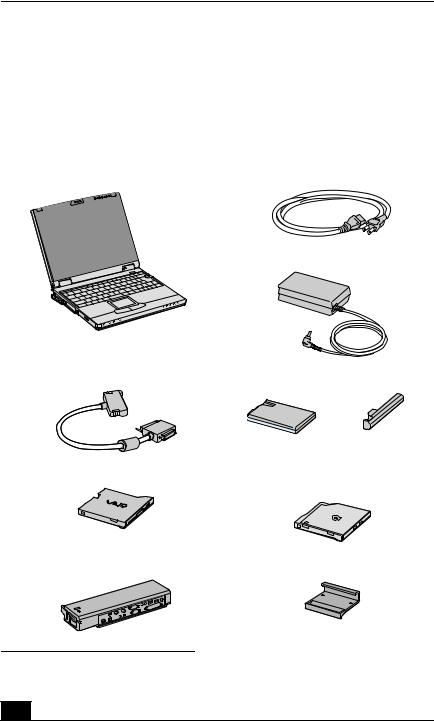
VAIO Notebook User Guide
your movies to CD-R or CD-RW media and share videos and images with family and friends.
Unpacking Your VAIO® Notebook
Remove the following hardware items from the box:
Main unit |
Power cord |
AC adapter
Floppy disk drive cable |
Rechargeable |
Weight saver |
|
battery pack |
|
Floppy disk drive (FDD) |
DVD-ROM drive or CD-RW drive |
|
(CD-RW drive on select models only) |
Mini docking station |
FDD stand |
‡ 530 MB after formatting with Direct CD™
14

Unpacking Your VAIO® Notebook
Manuals
VAIO® User Guide — Contains information on setting up your notebook, supplementary updates and software information. This manual describes the features and specifications of your notebook, the applications included with your system, how to contact software vendors, and solve common problems.
Microsoft® Windows® Millennium Edition Getting Started manual or
Microsoft® Windows® 2000 Professional Getting Started manual —
Explains how to use the basic features of this latest Windows operating system.
Software CDs
Microsoft® Word 2000 — Allows you to reinstall Microsoft Word to the Sony computer you purchased.
Recovery CDs
System Recovery CD(s) — Allows you to restore the software titles that shipped with your computer if they become corrupted or are erased. It can be used only to restore the hard disk of the Sony computer you purchased.
Application Recovery CD(s) — Allows you to reinstall individual applications or device drivers if they are corrupted or erased.
Driver Recovery CD(s) — Allows you to reinstall individual device drivers. Use it to restore corrupted or erased files.
Other
Setting up your VAIO® Notebook (poster)
Packet containing special product offers
15

VAIO Notebook User Guide
16
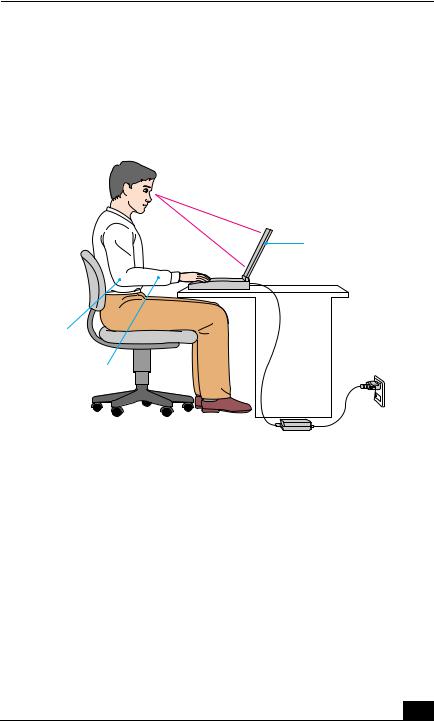
Ergonomic Considerations
Ergonomic Considerations
You will be using your notebook computer as a portable device in a variety of environments. Whenever possible, you should attempt to apply the following ergonomic considerations to both stationary and portable environments.
Ergonomic Position
Computer positioned directly in front of you
Arms at desk level
Wrists relaxed and flat
Position of your computer — Place the computer directly in front of you as you work. Keep your forearms horizontal, with your wrists in a neutral, comfortable position while using the keyboard, touchpad, or external mouse. Let your upper arms hang naturally at your sides. Take breaks during sessions with your computer. Excessive use of the computer may strain muscles or tendons.
Furniture and posture — Sit in a chair with good back support and armrests. Adjust the level of the chair so your feet are flat on the floor. A footrest may make you more comfortable. Sit in a relaxed, upright posture and avoid slouching forward or leaning far backward.
Viewing angle of the computer’s display — Use the display’s tilting feature to find the best position. You can reduce eye strain and muscle
17

VAIO Notebook User Guide
fatigue by adjusting the tilt of the display to the proper position. Adjust the brightness setting of the display also.
Lighting — Choose a location where windows and lights do not create glare and reflection on the display. Use indirect lighting to avoid bright spots on the display. You can also purchase accessories for your display that help reduce glare. Proper lighting adds to your comfort and work effectiveness.
Placement of an external display — When using an external display, set the display at a comfortable viewing distance. Make sure the display screen is at eye level or slightly lower when you are sitting in front of the monitor.
Notes on setup
Do not place your computer in a location subject to:
Heat sources, such as radiators or air ducts
Direct sunlight
Excessive dust
Moisture or rain
Mechanical vibration or shock
Strong magnets or speakers that are not magnetically shielded
Ambient temperature of more than 95º F (35º C) or less than 41º F (5º C)
High humidity
Do not place electronic equipment near your computer. The computer’s electromagnetic field may cause a malfunction.
Provide adequate air circulation to prevent internal heat buildup. Do not place your computer on porous surfaces such as rugs or blankets, or near materials such as curtains or draperies that may block its ventilation slots. Leave a space of at least 8 inches (20 cm) behind the back panel of the computer.
If the computer is brought directly from a cold location to a warm one, moisture may condense inside your computer. In this case, allow at least an hour before turning on your computer. If any problems occur, unplug your computer, and contact your Sony Service Center.
The computer uses high-frequency radio signals and may cause interference to radio or TV reception. Should this occur, relocate the computer a suitable distance away from the set.
18

Ergonomic Considerations
Use only specified peripheral equipment and interface cables; otherwise, problems may result.
Do not use cut or damaged connection cables.
If the telephone company makes a service call to your home or office and determines that your computer is responsible for a problem, the telephone company may bill you for the service call. Also, if you do not disconnect your computer when it is adversely affecting the telephone line, the telephone company has the right to disconnect your service until you correct the problem.
Handling your notebook
Clean the cabinet with a soft, dry cloth or a soft cloth lightly moistened with a mild detergent solution. Do not use any type of abrasive pad, scouring powder, or solvent such as alcohol or benzine, as these may damage the finish of your computer.
Should any solid object or liquid fall into the computer, shut down your computer and then unplug it. You may want to have the computer checked by qualified personnel before operating it any further.
Do not drop the computer or place heavy objects on top of the computer.
Make sure to disconnect the power cord before cleaning the computer.
Avoid rubbing the LCD screen as this can damage the screen. Use a soft, dry cloth to wipe the LCD screen.
Handling the LCD screen
Do not leave the LCD facing the sun as it can damage the LCD. Be careful when using the computer near a window.
Do not scratch the LCD or exert pressure on it. This could cause a malfunction.
Using the computer in low temperature conditions may produce a residual image on the screen. This is not a malfunction. When the computer returns to normal temperature, the screen returns to normal.
The screen becomes warm during operation. This is normal and does not indicate a malfunction.
The LCD is manufactured using high-precision technology. You may, however, see tiny black points and/or bright points (red, blue, or green) that
19

VAIO Notebook User Guide
continuously appear on the LCD. This is a normal result of the manufacturing process and does not indicate a malfunction.
Cleaning the display filter
1Remove the clips on the top of the display before removing the optional display filter as illustrated below.
Display Filter Clips
clips
2Hold the display filter by its sides to avoid leaving fingerprints on the display filter.
3Wipe off the fingerprints left on the display filter with the filter cleaner. You can use commercially available cleaners.
Do not use solvents such as alcohol or thinner, as they may cause damage to the surface of the display filter. When using other chemical solvents, read the instructions thoroughly.
4Insert the bottom of the display filter into the groove at the bottom of the display as illustrated below. Insert the display filter so that the clips’ protruding parts face left.
5Turn 90° to lock it in place.
20
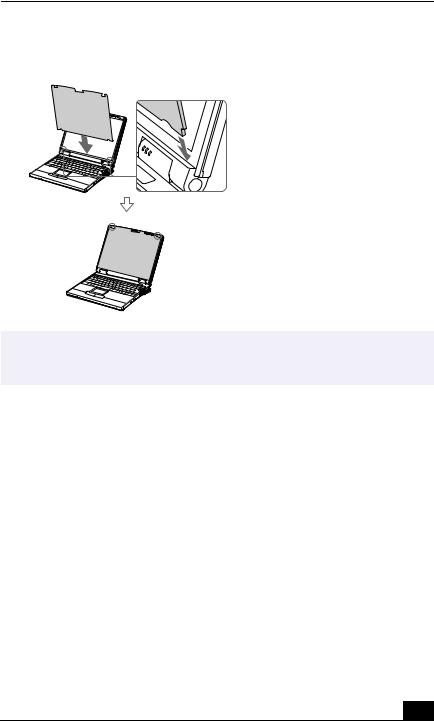
Ergonomic Considerations
Installing Display Filter

 clips
clips
Sony computer supplies, accessories, and peripherals can be purchased from your local retailer or by accessing the Sony VAIO DirectSM Website (http://vaio.sonystyle.com), or by calling 1-888-315-7669 (toll free).
21

VAIO Notebook User Guide
22
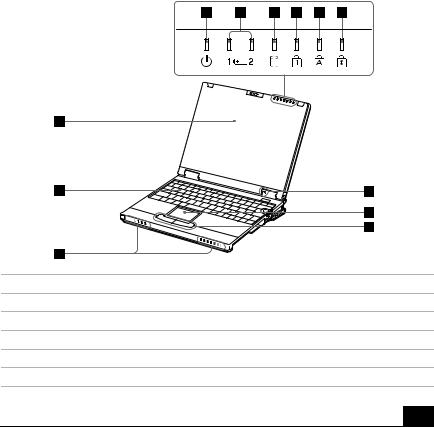
Setting Up Your VAIO®
Notebook
This section describes how to start using your computer and how to use your computer’s internal and external devices, such as the touchpad, floppy disk drive, and DVD-ROM or CD-RW drive.
Locating the Controls and Connectors
Front
1Power indicator
2Battery 1 and 2 indicators
3Hard disk drive indicator
4Num Lock indicator
5Caps Lock indicator
6Scroll Lock indicator
23
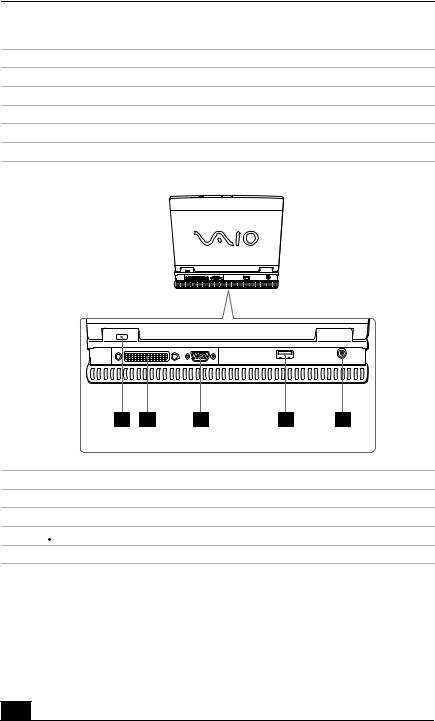
VAIO Notebook User Guide
7LCD (Liquid Crystal Display) screen
8Keyboard
9Speakers
10Internal microphone
11Touchpad
12Left and right buttons
Back
1Infrared port
2Docking / Floppy disk drive connector
3 Monitor connector
Monitor connector
4
 USB connector
USB connector
5 DC In connector
DC In connector
24
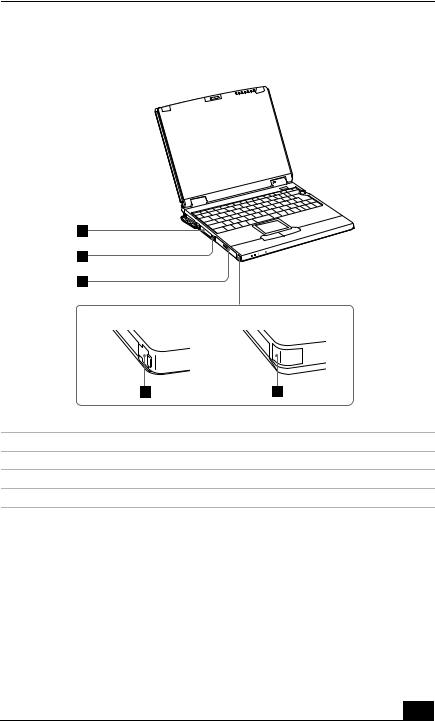
Locating the Controls and Connectors
Left
or
1PC card slots
2 i.LINK® (IEEE1394) S400 connector*
i.LINK® (IEEE1394) S400 connector*
3Battery bay
4Phone line jack
*i.LINK is a trademark of Sony used only to designate that a product contains an IEEE 1394 connection. The i.LINK connection may vary, depending on the software applications, operating system and i.LINK-compatible devices. All products with an i.LINK connection may not communicate with each other.
Please refer to the documentation that came with your i.LINK-compatible device for information on operating conditions and proper connection. Before connecting i.LINK-compatible PC peripherals to your system, such as a CD-RW or Hard Disk Drive, confirm their operating system compatibility and required operating conditions.
25
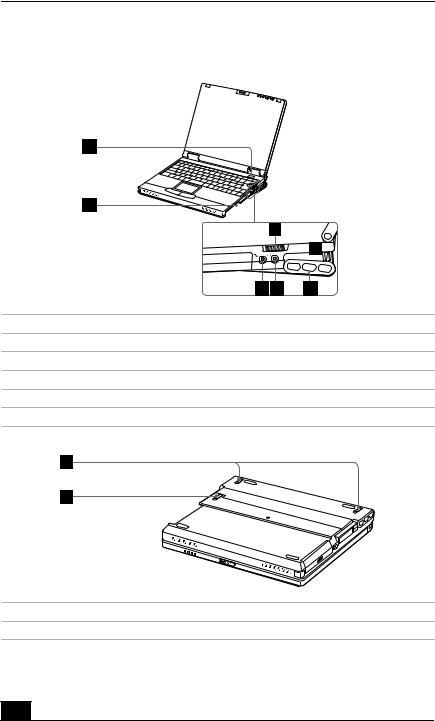
VAIO Notebook User Guide
Right
1Power button
2Multipurpose bay
3Jog Dial™ control
4Microphone connector
5Headphone connector
6Intercooler flap
Bottom
1Intercooler flap lever
2Multipurpose bay release lever
26
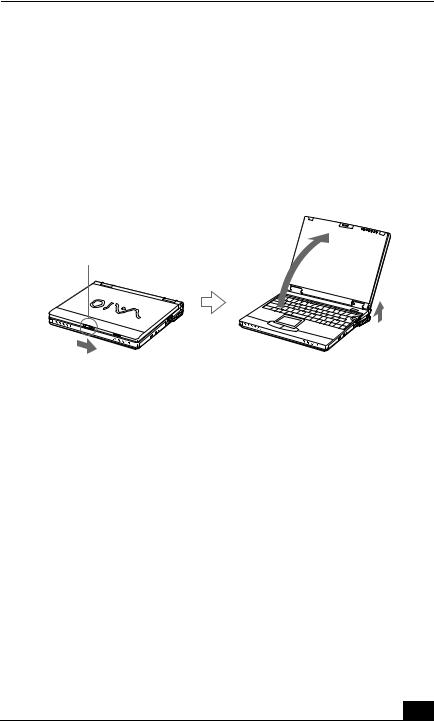
Connecting a Power Source
Connecting a Power Source
You can use either AC power or a rechargeable battery pack as a power source.
Using the AC Adapter
1Slide the LCD lock lever to your right.
2Open the computer.
Opening your Computer
LCD lock lever
3Plug the cable attached to the AC adapter into the DC In connector on the back of the computer.
4Plug one end of the power cord into the AC adapter.
5Plug the other end of the power cord into an electrical outlet.
27
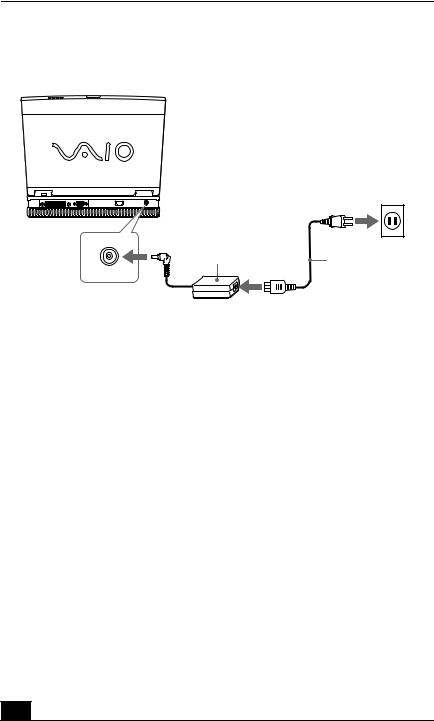
VAIO Notebook User Guide
Connecting the AC Adapter
Notebook
AC adapter (supplied) |
Power cord (supplied) |
|
DC In
Notes on the AC Adapter
Your computer operates on 100V-240V AC 50/60 Hz.
Do not share the AC outlet with other power-consuming equipment, such as a copy machine or shredder.
You can purchase a power strip with a surge protector. This device prevents damage to your computer caused by sudden power surges such as those that may occur during an electrical storm.
Do not place heavy objects on the power cord.
To disconnect the cord, pull it out by the plug. Never pull the cord itself.
Unplug your computer from the wall outlet if you will not be using the computer for a long time.
When the AC adapter is not used, unplug it from the AC outlet.
Use only the AC adapter supplied. Do not use any other AC adapter.
28
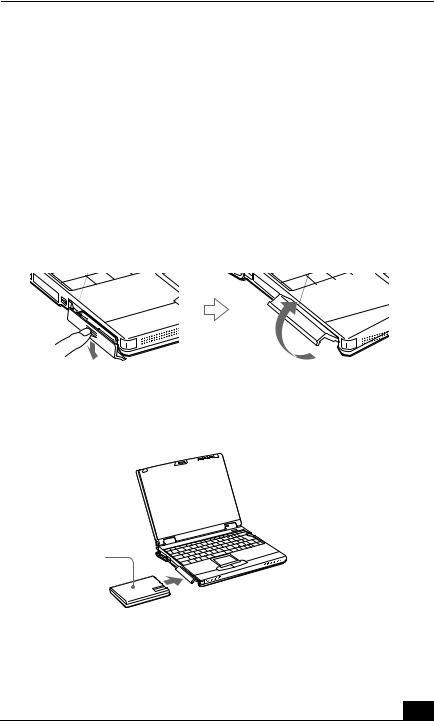
Connecting a Power Source
Using Battery Power
You can use one or two battery packs as a source of power. The second battery pack inserts into the drive bay on the right side of the computer. (See “Using a Second Battery Pack” on page 64.) Additional battery packs are available as a separate option.
The battery pack that comes with your computer is not fully charged at the time of purchase. Follow the steps below to insert and charge the battery pack.
To insert the battery pack
1 Open the cover of the battery bay on the left side of the computer.
Battery Bay
2 Insert the battery pack into the battery bay.
Inserting Battery Pack
Battery pack (supplied)
Label side facing down
29

VAIO Notebook User Guide
3 Close the cover of the battery bay until it clicks.
If the Mini Docking Station is attached to your computer, do not insert or remove the battery pack. Lifting and turning the computer with the Mini Docking Station attached may cause the Mini Docking Station to disconnect from the computer.
30
